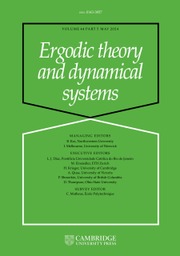No CrossRef data available.
Article contents
Quantitative ergodic theorems for actions of groups of polynomial growth
Published online by Cambridge University Press: 04 September 2025
Abstract
We strengthen the maximal ergodic theorem for actions of groups of polynomial growth to a form involving jump quantity, which is the sharpest result among the family of variational or maximal ergodic theorems. As two applications, we first obtain the upcrossing inequalities with exponential decay of ergodic averages and then provide an explicit bound on the convergence rate such that the ergodic averages with strongly continuous regular group actions are metastable (or locally stable) on a large interval. Before exploiting the transference techniques, we actually obtain a stronger result—the jump estimates on a metric space with a measure not necessarily doubling. The ideas or techniques involve martingale theory, non-doubling Calderón–Zygmund theory, almost orthogonality argument, and some delicate geometric argument involving the balls and the cubes on a group equipped with a not necessarily doubling measure.
Keywords
MSC classification
Information
- Type
- Original Article
- Information
- Copyright
- © The Author(s), 2025. Published by Cambridge University Press


